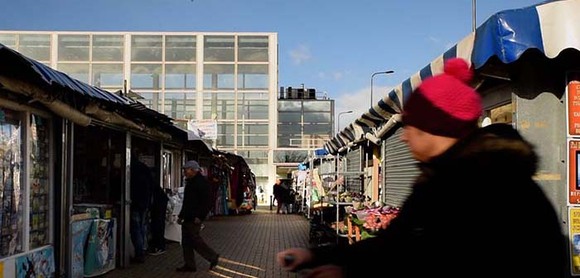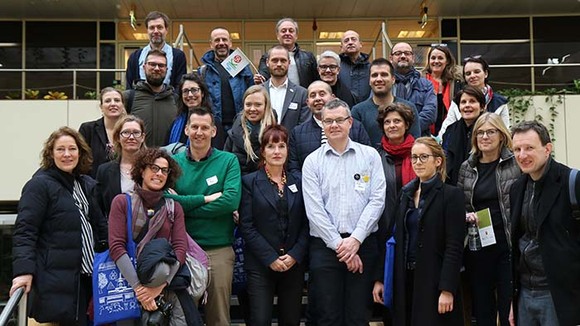
The refugee crisis has fuelled a global debate about migration. Taking a broader view, the New Towns Arrival Cities project focusses on migrants in general. European New Towns, at first composed entirely of newcomers, demonstrate how cities planned by the welfare state for homogeneous populations are adapting to increasing diversity. The two-day New Town Lab in Milton Keynes was the first of five labs that aim to address the topic of New Towns and migration and focussed on culture as its main theme. What is the main obstacle to integration, and how is it being addressed in Milton Keynes? INTI’s conclusions from the Lab, elaborated in the five main topics below, show that integration essentially requires recognizing newcomers as valuable members of the community, as opposed to an “us” versus “them” narrative.
Art and culture: Events provide a platform for dialogue and expression
“To be able to integrate, young people first need to understand who they are”
(Mike Kasibo, Founder of the Global Outreach Foundation: Milton Keynes)
If migrant communities are to be recognized and valued, they need to be known and understood. One of the challenges, for instance, is that many African youth are ashamed of their cultural roots because of the poverty portrayed on television. As well, there is a general lack of knowledge about their own cultural traditions. The African Diaspora Day, organized by the Global Outreach Foundation (GOF:MK), educates about African culture with food, music and local art. The annual Art in the Park festival, organized by the Milton Keynes Islamic Arts and Culture Organization (MKIAC), brings together multiple groups including the Islamic, Jewish and Sikh communities. Such initiatives are supported by the city.
Public space: A place where communities can meet and become visible
“The success of the city centre comes at the expense of social facilities”
(Mark Clapson, Professor of Social and Urban History at the University of Westminster)
With increasing population density and the privatization and commercialization of public spaces, there is a general lack of unprogrammed, neutral spaces that could give (migrant) communities a place to meet. The Town Centre for instance, originally planned as a bright and open public meeting place, has since become a private shopping mall that closes in the evening. The parks are almost the only remaining neutral public spaces, and some have become the hang-out places of troubled youth who have nowhere else to go. As neighbourhoods densify, it becomes increasingly important to provide social facilities such as community centres, youth centres, and neutral outdoor public spaces. Recognizing that the welfare state’s budgets for such facilities have largely disappeared, a partnership approach may be needed to offset the pressures on the public funds to meet these requirements.
Adapting the welfare state model: changing demands for housing and transportation
“The problem with regeneration is that it’s seen in architectural terms. The problem is actually poverty.”
(Roger Kitchen, Founder of Living Archive)
The Milton Keynes Development Corporation had a strong vision for Milton Keynes as a green city with a robust street grid, high-quality housing and social services. However, the car-oriented transportation network proved to be insufficient, and neighbourhoods are stricken with poverty. Those without a car, either because they are too young or cannot afford it, cannot easily move from place to place; there is no tram, and busses stop running after 21:00. In poor “grid square” neighbourhoods such as Netherfield and Fishermead, private sector renting has contributed to transient tenancy, posing an obstacle to forming stable communities. To address these social problems, regeneration efforts need to place greater emphasis on safeguarding support structures than on physical renewal.
Building a positive narrative: Understanding cultural differences
“I don’t know what to say to these people, because I don’t want to offend them.”
(GOF:MK Breakfast Club attendee)
Cultural differences and misunderstandings are a major obstacle to recognizing and accommodating migrant communities. For instance, the African custom of showing respect by avoiding eye contact and speaking softly is seen as disrespectful in the English context. Another example is Islamic women who, for religious reasons, need a separate swimming pool from men, but are told to use the general pool for cultural reasons of equality. The brochure picture of Milton Keynes for attracting newcomers has not yet caught up with the city’s cultural diversity, still portraying the ideal of suburban living with a townhouse, garden, car, and a white nuclear family. Working towards integration includes initiatives such as GOF:MK and the Great Linford Parish Council’s “Breakfast Club”, a regular meeting with guest speakers where all inhabitants are invited for breakfast and a discussion about cultural issues that affect their communities.
Government-citizen relations: Building trust is the key to establishing a dialogue
“Until people tell us what they want and what’s important to them, we can’t incorporate it into future plans.”
(David Gleeson, Managing Director of Your:MK)
Establishing trust between the municipality and the citizens is key for allowing community members to make their voices heard. Challenges in this regard are the municipality’s position of power, instances of not having delivered on promises, and neighbourhood organizations (so-called “parishes”) whose predominantly white and elderly members are not representative of their diverse communities. The strategy used by the Milton Keynes Council to reach out to various ethnic communities is to use private organizations such as MKIAC, which organizes events and school programmes, and GOF:MK which organizes, among other things, a platform for dialogue between the MK Police and African communities. While this strategy has proven effective in involving migrants in community life, it could introduce a potentially problematic blurring of religious interests and public services.
What are the next steps?
A more in-depth report of the Milton Keynes Lab will be published at the beginning of the new year. The New Towns Arrival Cities project will then continue with New Town Labs in Sabaudia (Italy) in May 2018, Grand Paris Sud (France) in October 2018, Vällingby (Sweden) in December 2018, and Nissewaard (The Netherlands) in February 2019. Thank you to the local partners and to all the international delegates who attended (pictured below)!




